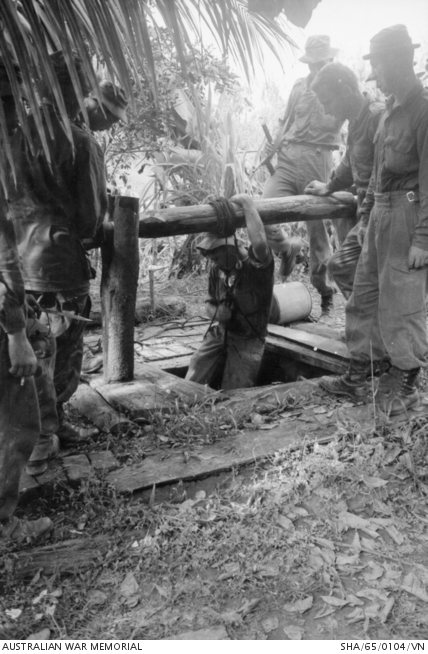In Vietnam and Laos, there are still 1,582 military personnel who are unaccounted for. The people who returned were also forever changed by their experiences in the Orient. How did these men get so affected? What terrifying experiences altered their mental state, and what monsters and abominations did they encounter in the Indo-Chinese jungles that contributed to the Vietnam War’s notoriety as one of the scariest military conflicts?
A former navy diver has broken down at an inquiry, alleging the ADF breached privacy laws to discredit him after he made a complaint
Story by ABC court reporter Jamelle Wells
The final block of the Royal Commission into Defence and Veteran Suicide sitting in Sydney is focusing on leadership and accountability.
Witness John Armfield told the Commission today that after his brother Andrew took his own life in 2011, it was months before he could obtain a copy of an internal report.
It arrived by registered post, and he sobbed as he read the document alone outside his local post office.
“I was sitting in my car broken. I had loyally served my nation. I had recruited for my nation…..they left me on my own.”
The witness said he received letters dismissing his complaint about the report process and lack of support.
He sought counselling, but alleged ADF officials tried to discredit him.
Mr Armfield said privacy laws were broken after documents about his mental health and his brother’s suicide were placed in an internal electronic document storage system called “Objective.”
“We are not the cause of the ADF’s troubles. Our data analysis has confirmed that their greatest enemy lies within the ADF itself and its resistance to change,” he said.
Deputy Prime Minister and Minister for Defence, Richard Marles and Minister for Defence Personnel and Veterans’ Affairs, Matt Keogh are due to give evidence on Thursday.
Date: 1965
Location: Xam Cay Xaoi village, Cong Thanh district, Bien Hoa province, Vietnam
In the thick of the Vietnam War, Australian forces found themselves embroiled in the intricate cat-and-mouse game of guerrilla warfare against the Viet Cong. One pivotal chapter of this saga unfolded in the unassuming village of Xam Cay Xaoi, nestled within the rugged terrain of Bien Hoa province. Here, amid the verdant landscapes and sweltering humidity, Australian sapper Bill Murray from Slack’s Creek, near Brisbane, descended into the depths of darkness, venturing into the unknown abyss of a clandestine underground tunnel system.
The year was 1965, and members of the 3rd Field Troop, Royal Australian Engineers, were on a mission to root out Viet Cong hideouts lurking beneath the surface. Armed with courage and determination, these engineers embarked on a perilous quest to unravel the secrets concealed within the earth. As they combed through the village, their vigilant eyes caught sight of a seemingly innocuous well, its yawning mouth beckoning towards the unknown depths below.
With a sense of trepidation mingled with resolve, Bill Murray, representing the indomitable spirit of the Australian contingent, descended into the abyss. Down, down he went, into the murky darkness, his senses heightened, his heart pounding with anticipation. Around him, the echoes of history whispered through the labyrinthine tunnels, each twist and turn a testament to the ingenuity of the enemy they sought to vanquish.
The discovery that awaited them beneath the surface surpassed their wildest imaginings. A sprawling network of tunnels, meticulously carved into the earth, stretched out before their eyes like a subterranean maze. Each passageway held the promise of danger, concealing booby traps and ambush points crafted by the elusive Viet Cong.
Undeterred by the perils that lurked in the shadows, the Australian engineers pressed forward, their determination unwavering. With meticulous precision, they mapped out the intricate layout of the tunnels, documenting every twist and turn, every concealed alcove that could serve as a haven for the enemy.
Yet, their mission was not merely one of reconnaissance. Armed with explosives and resolve, they set out to neutralize this subterranean threat once and for all. With expert skill, they planted charges at strategic points throughout the tunnel network, preparing to unleash a cascade of destruction upon their hidden adversaries.
As the explosives detonated with thunderous force, the earth shook, and the tunnels collapsed in a symphony of chaos. The once-impenetrable fortress of the Viet Cong lay in ruins, its secrets laid bare for all to see. The Australian engineers emerged from the depths, victorious but humbled, their courage immortalized in the annals of history.
The encounter in Xam Cay Xaoi village stood as a testament to the valour and determination of the Australian forces in the face of adversity. It was a pivotal moment in the long and arduous struggle for control of Vietnam’s contested landscapes, a reminder of the sacrifices made by those who dared to venture into the heart of darkness in search of victory. And though the echoes of that fateful day may have faded into the mists of time, the legacy of those brave men, like sapper Bill Murray, endures as a beacon of hope amidst the shadows of war.
One of the biggest concerns for aircraft carriers is the risk of US Navy sailors or planes falling overboard. This warship has more than 6000 sailors on board, nearly 100 fighter jets worth over 30 million dollars each, and many luxury amenities you’d find in a city. It weighs more than 100,000 tons and is over 1000 feet long.
On July 8th 2022, a fighter jet flew off the deck of the mighty USS Harry S. Truman due to unexpectedly violent weather in the Mediterranean Sea. This shocking incident raised suspicion as to how the events took place considering the capability of the aircraft carrier to withstand harsh weather conditions. How did this happen and what happens when an aircraft carrier runs into a heavy storm? How does such a massive ship manage to stay level and prevent millions of dollars worth of aircraft from drowning in the deep ocean?
Story by Tim Barlass and Peter Jones
Rear Admiral Guy Griffiths (Ret’d), aged 101, was the last survivor in Australia of HMS Repulse, which was torpedoed and sunk in a Japanese air attack in 1941, along with the Prince of Wales off Malaya as part of the war in the Pacific with heavy losses.
It was an illustrious career. From late 1973 to mid-1975, Rear Admiral Griffiths commanded the aircraft carrier Melbourne, which was flagship of the Australian fleet. In June 1976, he was promoted to Rear Admiral and appointed Chief of Naval Personnel.
Guy Griffiths was born in Sydney on March 1, 1923. He grew up in the Hunter Valley and descended from four pioneering, wine-producing families.
CLICK LINK to continue reading about this amazing man.
Exceptional rear admiral was last survivor of torpedoed HMS Repulse (msn.com)
In the wake of the Dunkley by-election, the Coalition has unveiled a revamped shadow ministry, signalling their readiness for the challenges ahead leading up to the next election.
Opposition Leader Peter Dutton expressed confidence that the new appointments would fortify the Coalition team for the crucial tasks on the horizon. The reshuffle comes in the aftermath of the Dunkley by-election, where Labor retained the seat, but the Liberals secured a notable 3.6 percent swing.
Among the key changes, Queensland’s Luke Howarth has been elevated to the position of shadow assistant treasurer and minister for financial services. Melissa McIntosh, a representative from New South Wales, will now shoulder the responsibility of shadow minister for energy affordability, with a focus on Western Sydney. Meanwhile, Victorian Senator James Paterson will assume the role of shadow cabinet secretary alongside his existing portfolio in home affairs.
Further strengthening the lineup, Western Australian MP Andrew Hastie will take on the dual role of shadow minister for defence industry and defence personnel, building upon his existing position within the defence portfolio.
Leader of the Opposition Peter Dutton emphasized the quality of the appointments, emphasizing unity within the Coalition and a continued dedication to addressing pertinent policy issues.
Additionally, several parliamentarians have been promoted to shadow assistant minister positions. Andrew Bragg from New South Wales will now serve as shadow assistant minister for home ownership, while James Stevens from South Australia will focus on government waste reduction. Queensland’s Phillip Thompson will expand his responsibilities to include assistant minister for defence industry and personnel.
Furthermore, Queensland Senator Paul Scarr will take on the role of shadow assistant minister for multicultural engagement, while New South Wales Senator Hollie Hughes will assume responsibility for mental health and suicide prevention, as well as the National Disability Insurance Scheme.
As the Coalition prepares for the forthcoming election, these appointments reflect a strategic reshuffle aimed at addressing key policy areas and presenting a strong alternative vision for Australia’s future.
RSL LifeCare receives $5.445 million in funding provide holistic support for veterans from Hawkesbury Western Sydney
RSL LifeCare, in partnership with RSL NSW and sub-Branches, will today receive a $5.445 million grant from the Federal Government to develop a Veterans’ and Families’ Hub network, connecting the Hawkesbury region to South Western Sydney.
The initiative will establish a corridor of support, bookended by two Veterans’ and Families’ Hubs, one in the Hawkesbury region, and one in South Western Sydney, to ensure that the 19,200 local veterans in the area can access services close to home.
The announcement follows RSL LifeCare successfully completing the final stage of the bid for the new facilities, part of the Government’s $46.7 million commitment to deliver 10 new Veterans’ and Families’ Hubs across the country. The development complements the recently successful bids for two new Hubs in Queanbeyan and the Central Coast region, as well as existing hubs in Nowra, the Northern Beaches and the Riverina and Hunter regions.
The new facilities will enable RSL LifeCare to implement a ‘hub and spoke’ model, developed in consultation with the local communities and other ex-service organisations, through the network of RSL sub-Branches. Through this model, the Veterans’ and Families’ Hubs act as primary care centres with RSL sub-Branches providing flexible and innovative care solutions for veterans and their families.
RSL LifeCare CEO Janet Muir said that the successful bid was another essential milestone for RSL LifeCare’s commitment to supporting veterans and their families.
“We are thrilled to be able to fulfill our vision of creating a corridor between the Hawkesbury and South Western Sydney that will deliver a comprehensive and efficient support network for veterans and their families across the Hawkesbury and South Western Sydney regions,” Ms Muir said.
“We thank RSL NSW and sub-Branches for their ongoing partnership which helps us collectively bring significant and valuable resources to the delivery of these Hubs.”
Minister for Veterans’ Affairs Matt Keogh said:“We’re developing Veterans’ and Families Hubs across the country to suit the needs of the local veteran community. This unique network will support the corridor of veterans living in the beautiful Blue Mountains in the Hawkesbury region and in South Western Sydney.
“We’re working to make sure each Hub around the country is easily accessible and available to local veterans, to support them and their families close to home.
“It’s fantastic to see so many organisations join with RSL LifeCare – including Legacy, Invictus, the Defence and Veterans Legal Service, Disaster Relief Australia, Veteran Gaming Australia and many others, come together to provide the best possible services and supports to local veterans.“
Last year, RSL NSW sub-Branches donated $3.3 million to RSL LifeCare to ensure that veterans and their families continue to receive free critical services and support, including access to local Veterans’ and Families’ Hubs.
RSL NSW President Mick Bainbridge said “RSL NSW is committed to supporting RSL LifeCare’s Veterans’ and Families’ Hubs because we know they work.
The expansion of Hubs in locations with significant Defence and veteran communities is a strong step in the right direction to bolstering the support we deliver to Australian servicemen and women, and their families.”
RSL LifeCare Veteran Services, Executive General Manager, David Anderson said this accomplishment supported the organisation’s goal to establish centres of support for veterans and their families across NSW and the ACT.
“Thanks to the generous funding from the Government, we can provide support to even more veterans across two of NSW’s major regions. This unique approach to providing one-stop-shops for vulnerable members of our community is a big step toward giving veterans the support they need and deserve.”
RSL LifeCare Veteran Services will work with a consortium of ex-service organisations and local providers to offer a holistic model for the delivery of critical services and support at the centre of the Veterans’ and Families’ Hub strategy.
Lockheed Martin unveiled its ambitious endeavour to bolster the US Army’s short-range air defence capabilities with the announcement of their latest innovation: DEIMOS, standing for Directed Energy Interceptor for Maneuverer of Short-Range Air Defence. Spearheaded by Tyler Griffin, Lockheed’s director of laser and sensor systems, DEIMOS represents a cutting-edge leap forward in military technology. This 50-kilowatt laser weapon is poised to revolutionize the battlefield, offering unparalleled precision and efficiency in neutralizing aerial threats.
With the rapid evolution of modern warfare and the escalating demand for advanced defence systems, Lockheed Martin recognizes the imperative to stay ahead of the curve. The development of DEIMOS signifies a strategic move to anticipate and address future challenges in securing the nation’s airspace.
This ambitious project comes at a pivotal moment, as Lockheed aims to challenge the dominance of the incumbent team comprising Raytheon and Kord Technologies. This summer, Raytheon and Kord Technologies clinched a substantial $123.9 million contract to construct a Directed Energy Maneuverer Short Range Air Defence system (DE M-SHORAD). However, Lockheed Martin’s entry into the arena introduces a formidable competitor, poised to disrupt the status quo and set new benchmarks for performance and innovation in the realm of short-range air defence.
As Lockheed Martin ventures into uncharted territory with DEIMOS, they are not merely building a weapon; they are shaping the future of military defence. With a steadfast commitment to excellence and a relentless pursuit of technological advancement, Lockheed Martin is poised to redefine the landscape of short-range air defence, ensuring the safety and security of the nation for years to come.
The CH-53 is a heavy-lift cargo helicopter used primarily by the United States Marine Corps. It is one of the largest and most powerful helicopters in the U.S. military inventory. The CH-53 has a long history of service, with various models and upgrades over the years.
Here are some key features and specifications of the CH-53:
- Size and Capacity: The CH-53 is a large helicopter capable of carrying heavy loads. It has a length of around 88 feet (26.8 meters) and a height of around 28 feet (8.5 meters). It can carry a maximum payload of up to 36,000 pounds (16,329 kilograms) internally or externally.
- Power: The CH-53 is powered by three turboshaft engines, typically the General Electric T64 or the more recent General Electric T408 engines. These engines provide the helicopter with significant power to lift heavy loads and operate in various environmental conditions.
- Performance: The CH-53 is capable of flying at speeds of up to 170 knots (196 mph or 315 km/h) and has a maximum range of over 500 nautical miles (575 miles or 926 kilometers). It can operate at high altitudes and in hot and dusty environments, making it suitable for a wide range of missions.
- Role: The primary role of the CH-53 is heavy-lift cargo transportation. It can transport troops, vehicles, artillery, and other equipment both internally and externally. It is also used for search and rescue (SAR) missions, disaster relief, and special operations support.
- Variants: Over the years, several variants of the CH-53 have been developed and deployed by the U.S. Marine Corps. These include the CH-53A, CH-53D, CH-53E Super Stallion, and the latest variant, the CH-53K King Stallion. Each variant has seen improvements in performance, payload capacity, and overall capabilities.
- Modernization: The latest variant, the CH-53K King Stallion, features advanced technologies and improvements over its predecessors. It has enhanced lift capability, improved reliability, and reduced maintenance requirements compared to earlier models. The CH-53K is designed to meet the future heavy-lift requirements of the U.S. Marine Corps.
Overall, the CH-53 is a critical asset for the U.S. military, providing heavy-lift capabilities essential for transporting troops and equipment in various operational scenarios. Its reliability, versatility, and impressive lifting power make it one of the finest helicopters in the U.S. military inventory.
Get a behind the scenes look at an Australian Army Artillery Gun Line.









